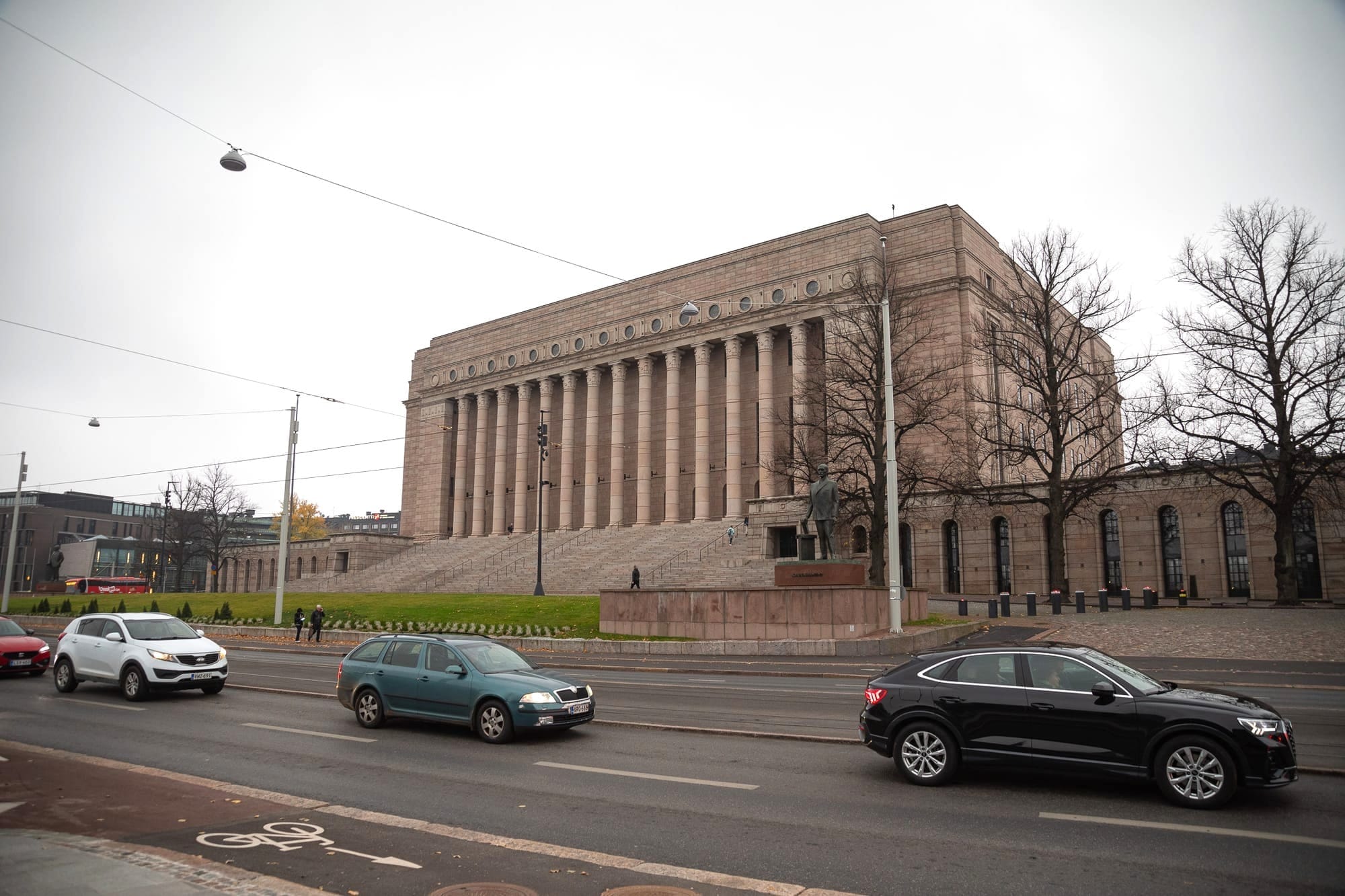The Greens joined Finland’s 'debt brake' deal
All parliamentary parties except the Left Alliance reached this week an agreement on Finland’s so-called debt brake – a cross-parliamentary commitment to long-term fiscal policy. The result, say Green negotiators Hyrkkö and Harjanne, is a clear improvement on the original proposal.

By Kalle Pusa
Finland’s parliamentary parties reached an agreement on Tuesday on the so-called debt brake – a framework intended to set long-term rules for managing public debt. The Left Alliance was the only party to stay outside the deal.
The debt brake aligns with the EU’s new fiscal policy rules, effectively tightening them at the national level. While EU rules allow member states to run a deficit of up to 3 per cent, Finland’s version lowers the limit to 2.5 per cent.
The parties also agreed to aim first at reducing the debt-to-GDP ratio to the EU threshold of 60 per cent, and later to 40 per cent. In addition, they committed to cutting the debt ratio by 0,75 percentage points per year.
The arrangement also sets new ground rules for the Finnish Parliament. Under the new system, the parties will jointly define debt-reduction targets for both four-year and eight-year terms, ensuring that the fiscal framework extends beyond a single government’s term. The first working group is expected to be appointed in October.
This marks a historically unusual decision: for the first time, Finnish parliamentary parties have agreed on a fiscal policy that transcends electoral cycles.
EU sets the rules – Finland follows
The debt brake is rooted in the EU’s new fiscal framework, which Finland must incorporate into its national legislation. All parliamentary parties, including the Left Alliance, have committed to those EU-level requirements.
Finland had little room to manoeuvre on the EU rules themselves. Debate focused instead on whether additional national restrictions were necessary. During the negotiations, opposition representatives questioned the need for stricter limits than those already imposed by the EU.
The government’s initial proposal was adjusted as talks progressed. Based on public reports, negotiators from the SDP, Greens, and Centre Party helped shape a compromise more acceptable to the opposition.
The Left Alliance ultimately opted out, criticising Finland’s decision to set tighter debt goals than those required by the EU. Party chair Minja Koskela said at a press conference that “the debt brake is either unnecessary or unnecessarily harmful.”
A signal to credit rating agencies
Marketta Henriksson, Finance Ministry senior advisor and head of unit, served as an expert in the negotiations. She – and the ministry as a whole – has long advocated for a debt brake–type system for Finland.
“It would demonstrate broad commitment to correcting public finances and send a positive signal to those assessing Finland’s economy,” Henriksson told MTV News.
By “those assessing,” she referred to international credit rating agencies. One of them, Fitch Ratings, downgraded Finland’s rating from AA+ to AA in July 2025, citing the country’s persistent fiscal deficit as a key concern.
A downgrade means higher borrowing costs for the Finnish state. Even small increases in interest rates can translate into billions in additional public spending.
For many observers, the substance of the agreement itself may be less significant than the symbolism of the cross-party consensus. It signals that Finland is responding to its fiscal challenges with unity.
Greens’ criticism eased during negotiations
The Green parliamentary group joined the deal alongside the SDP, Centre Party, and the governing parties. The Greens were represented in the talks by MP Saara Hyrkkö, the group’s deputy chair, and MP Atte Harjanne.
Their participation may surprise some: as recently as August, the Greens had expressed strong reservations about the proposal. Verde earlier reported that the party viewed the plan as overly rigid.
“From international examples we know that a debt brake can constrain the economy in ways that are neither wise nor effective. The government’s draft was overly strict and risked triggering a self-reinforcing cycle of cuts,” Hyrkkö said at the time.
However, the Greens’ stance changed as the proposal evolved.
“We negotiated to the very end to make sure that common sense still prevails in Finland. Without the flexibility provisions the Greens secured, the model would have been far too rigid,” Hyrkkö said in a party statement.
She added that she was pleased the final model allows flexibility in times of crisis. The agreement explicitly states that the debt brake will not prevent Finland from responding to global crises such as pandemics, conflicts, or environmental emergencies.
Harjanne echoed that view.
“The Greens believed no additional national restrictions were needed – and many economists agreed. Still, experts have stressed the value of broad, cross-parliamentary cooperation. That’s why we felt it was responsible to take part in shaping the final outcome,” he told Verde.
“Thanks to our involvement, the end result is clearly better than the original government proposal,” Harjanne added.
Tynkkynen: The final deal differs from the government’s original proposal
Some Green activists have publicly voiced disappointment with the outcome, posting messages on social media supporting the Left Alliance’s decision to reject the deal and criticising the Greens’ participation.
The concept of a debt brake has long been promoted by the National Coalition Party. Prime Minister Petteri Orpo raised it already before the 2019 parliamentary elections, and former president Sauli Niinistö also spoke favourably of a similar mechanism in his final address to Parliament.
Critics on social media have argued that the cross-party deal effectively endorses National Coalition-style economic policy – or even marks “the funeral of the welfare state.”
Green parliamentary chair Oras Tynkkynen offered his perspective in a blog post, arguing that public debate has sometimes conflated the government’s initial draft, which the Greens opposed, with the improved agreement now reached.
According to Tynkkynen, it also became clear during the September talks that the government would have enough parliamentary support to pass the debt brake regardless.
“It was obvious that the debt brake would go through with the government, the Centre, and the SDP, with or without the Greens,” he wrote.
“We chose to participate and influence – and thanks to that, the outcome is significantly better than the original proposal.”
Tynkkynen emphasised that it is important for the Greens to be part of a model that will shape Finland’s economic policy for years to come.
Shared rules, not just numbers
Beyond the exact deficit or debt targets, many view the process itself as the most important outcome. Finland now has a cross-parliamentary mechanism committing parties to shared fiscal goals that extend beyond a single government term.
In an interview with Yle, Roope Uusitalo, professor of public economics at the University of Helsinki, said the agreement could even improve Finland’s political culture – shifting debate away from mere spending cuts toward policy substance.
“Instead of arguing over euros, the discussion could focus on how those savings are achieved,” Uusitalo said.
He added that the long-term framework should not overly constrain future governments’ ability to pursue their own policies, while the near-unanimous commitment to long-term fiscal responsibility is, in itself, highly valuable.
SDP chair Antti Lindtman noted in Yle’s A-studio on 14 October that Finland’s debt brake partially mirrors Sweden’s model. Sweden has had a similar system – effectively a debt anchor – since 2019, with parties agreeing on shared debt targets before elections.
In Sweden, the public debt ratio has been declining since the 2010s, while Finland’s has continued to rise. Critics point out, however, that Sweden’s success stems more from its stronger economic structure than from the debt brake itself.





